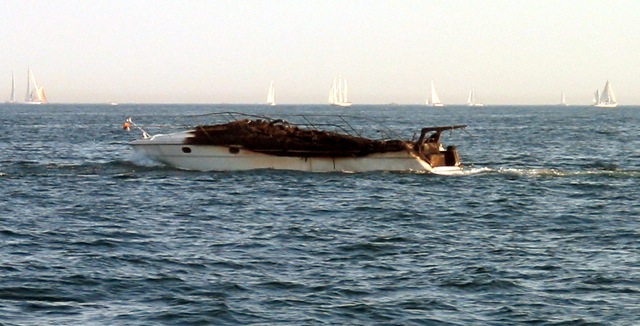Fire Safety
Following the code and listening to our fire consultant
Fire is one of the most serious situation one can have on a boat, which anyone will agree with on after having joined a proper fire fighting course. Fire should hence be avoided by all means. Smoking should not be allowed, gas- and electrical appliances should be installed professionally, a burning flame (in the galley or a candle) should always be watched, a gas remote switch (solenoid) should be installed for the cocking gas and any combustible items (especially liquids) must not be stored in the engine room.
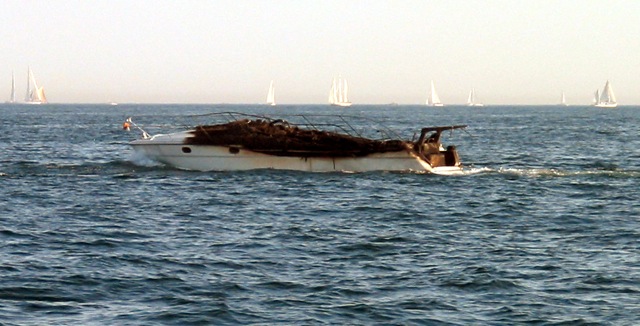
A totally burnt out powerboat as seen by us while sailing in Norway during the summer 2004. It all went very quickly
If a fire occurs nevertheless, it should not spread and it must be extinguished quickly and effectively without destroying everything else while doing so. Powder, for instance, is a nasty medium and by using such an extinguisher for a small fire only, the consequences of the fire-fighting itself can become unnecessarily expensive.
In order to sail commercially, Regina Laska needs to follow the MGN280 rules, where safety plays a major roll. There are a lot of guidelines to comply with. Luckily, we are working with Pelle Sundbye as our fire safety consultant. I think it is important to complies with, or -better- to exceeds the mentioned rules.
Karolina and Leon at a sea survival course
organized by the German Navy, Neustadt
Passive fire safety
First of all, the engine room needs to be covered with fire resistant material in order to prevent the passage of smoke and flames to other parts of the boat for 15 minutes (MGN 280, Rule 14.2.2). All Hallberg-Rassy’s fulfill this rule since the engine room is covered with sound-insulation which, in turn, is covered by a fire resistant metal surface as standard.
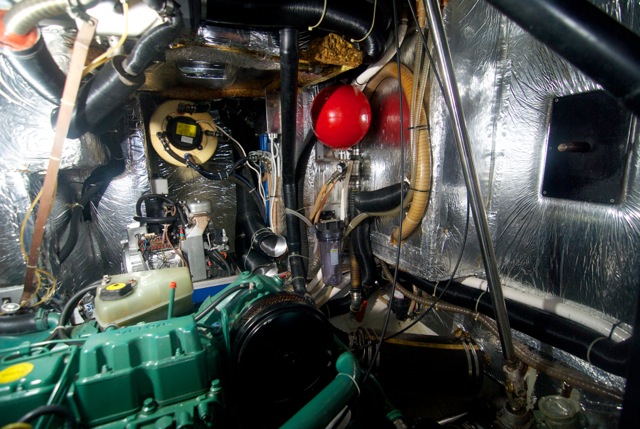
The engine room of Regina Laska is already covered with fire resistant sound insulation as all Hallberg-Rassy’s are
In our case, sailing commercially in Area 1 or 0 (150 nm from safe haven or unlimited ocean sailing, respectively) all pipes and hoses leading to a through-hull in the engine room have to be fire proof as well. This is solved either by having metal pipes leading to the through hulls or the hoses in question have to be covered by a special outer fire resistant hose. This fire protection prevents fire to melt the hoses, which could lead to water penetrating the engine room via the through-hulls, flooding the boat. The cockpit drains in a HR46 are already made of metal, but the remaining hoses leading to through-hulls, such as the toilet outlet or the cooling water inlet for engine and generator have to be covered up to the sea level.
The gas stove is another fire-risk on the boat and therefore no combustible material must be closer to the stove burner than 400mm vertically above or 125mm horizontally to the side of it (Rule 14.5.1). This is already dealt with by Hallberg-Rassy as standard. In addition to this, we will have the underneath of the lid over the stove acting as a fire wall behind the stove when it is folded up in an upright position.
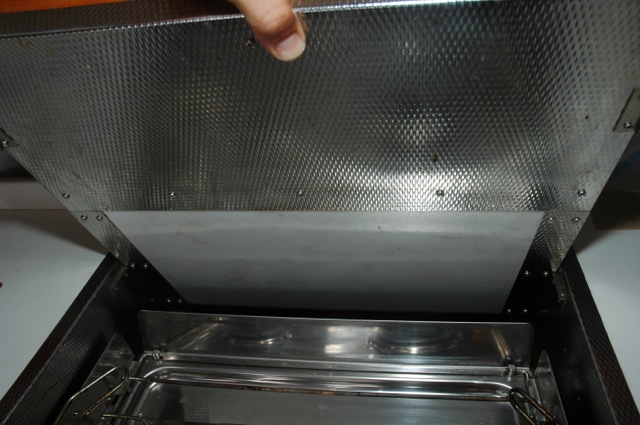
The lower side of the stove lid becomes a fire resistant wall when placed vertically behind the stove
Alarms
The rules say you need a fire alarm in an area which is posing a fire risk. In our case this the galley (rule 14.7.3). In addition to this we need a fire alarm in all accommodations which do not have two exits (rule 14.8.2). On a HR46 all accommodations (fore-cabin, side cabin and aft cabin) have a hatch as a second exit and hence escape route. Therefore, we would not need fire alarms in these compartments.
However, there could be a situation, such as when we have a dinghy on the coach roof, that the second escape route is obstructed and therefore we will install four fire alarms in total, one in each cabin and one in the saloon. These will be wirelessly interlinked so they all go off when a fire is detected in one of the cabins, thereby fulfilling rule 14.7.4 saying that the alarm should be heard at the “control position”.
Since Regina Laska will be coded for Area 1 (150 nm from safe haven), we also need a fire alarm in the engine room. This will be dealt with by a special fire-detection cable that melts and makes a short-cut if the temperature exceeds 105 deg C. This short-cut triggers a fire-alarm summer.
Fire Fighting
Fire fighting is done by means of a fire blanket, water, CO2, foam and powder. The MGN280 rules are not very stringent when it comes to number, type and size of fire extinguishers, so here, we will exceed the rules by far. For instance, there is no need for a “C” extinguisher for fighting a gas fire, despite the fact that we do have gas onboard. Obviously, we will therefore also carry a C-classed extinguisher.
A major problem with fire extinguishers is that when you use them you destroy so much in the boat that the cost for repair becomes a major one, while you could have put out a small fire much more efficient and non-destructive with another type of extinguishers. I do thus not agree with the Swedish habit to only install powder extinguishers in a boat. Yes, they do put out any type of fire, but to what price?
Instead, we will place the various extinguishers depending on the order that they should be used, the most harmless first (fire blanket and CO2) and the worst-case extinguishers last (powder), which is to be used when nothing else helps and you don’t care if the equipment and interior is destroyed as well. In between we have the foam extinguisher that is slightly less efficient but does considerably less harm to the boat.
Fire Blanket
Regina Laska will have one fire blanket (1,8 x 1,5 m) which is placed close to the stove (Rule 15.4.4). This is the first mean of putting out a small fire over the stove, for instance.
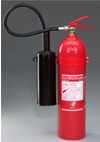 CO2
CO2
Also close to the stove in the saloon and clearly visible, there is a 3 kg CO2 extinguisher classed 34B. CO2 is an excellent extinguisher for small fires, since it doesn’t destroy anything and doesn’t leave any stains or marks. It is totally harmless for electronics and very useful in confined spaces such as a cupboard (electric fire) or the engine room (see more about that below).
Also placed in the cockpit locker, hidden out of the way, is a 10 kg CO2 extinguisher with a manual remote wire release and a piping system reaching down below directly into the 5 m3 engine room. This fixed installed CO2 system for the engine room is the primary means of fire-fighting of an engine room fire, fulfilling rule 15.6.2. The advantage of the CO2 is that it does not destroy anything in the engine room and the engine(s) will stop automatically as well, lacking the necessary oxygen for internal combustion. As a second mean of fire fighting in the engine room, to be used as a last desperate trial to stop an engine room fire, there is a fire plug hole into the engine room, so you can spray powder into the engine room. Anything in the engine room will be destroyed at the same time and this is clearly only to be used to save the boat and your life, if there no other way to stop the fire.
Foam
In each accommodation cabin (fore peak, side cabin an d aft cabin) there is a 2 liters 21A183B foam extinguisher, i.e. three in total, which exceeds rule 15.4.2 stipulating a 5A34B extinguisher in each cabin. Foam is the third mean of extinguisher after the fire blanket and the CO2 extinguisher.
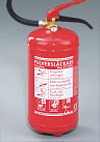 Powder
Powder
In the saloon is a 2 kg powder extinguisher classed 13A89BC and in the cockpit locker there is yet another powder extinguisher of 6 kg classed 55A233BC, in other words by far surpassing rule 15.4.1 that stipulates no more than a 13A/113B extinguisher and then again only in case you do not carry a water fire pump. We will have both:
– A water fire pump consisting of our Jabsco PAR4 deckwash pump connected to a hose with a fire nozzle, by Hosecoil Washdown systems and
– the bespoke 6 kg 55A233BC powder extinguisher which can fight a gas fire as well (the “C”).
The powder extinguisher is filled with Tempus high efficient G-powder Multimax, containing 94% ammonium phosphate and since it does not conduct electricity, is good for electrical fires as well.
LithEx
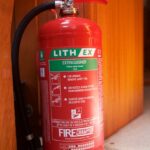 More and more sailors install Lithium batteries, which was reason enough for me to write an article in a recent issue of YACHT (No 8/2019) about fire safety and Lithium Batteries. But even without domestic Lithium batteries, literally all boats have Lithium batteries onboard by means of all computers, tablets, smartphones, electric tools etc. These chemical fires can be really nasty, especially if their runaway temperature has been reached and the devices continue to create heat up to several thousand degrees C.
More and more sailors install Lithium batteries, which was reason enough for me to write an article in a recent issue of YACHT (No 8/2019) about fire safety and Lithium Batteries. But even without domestic Lithium batteries, literally all boats have Lithium batteries onboard by means of all computers, tablets, smartphones, electric tools etc. These chemical fires can be really nasty, especially if their runaway temperature has been reached and the devices continue to create heat up to several thousand degrees C.
For this reason, there is a new extinguishing liquid called AVD by Dupré Minerals Ltd in the UK, especially designed to cool down Lithium fires. The trade name of the extinguishers is LithEx and they have just been certification for EN3-7. I am proud to be one of the first boats on the market that received a LithEx extinguisher in order to enhance safety even further onboard.
I now have no less than 8 fire extinguishers onboard, ranging from CO2 via Foam and Powder to AVD.
Fire Bucket
Rule No 15.4.3 talks about the sweet necessity to carry two fire buckets with lanyards. They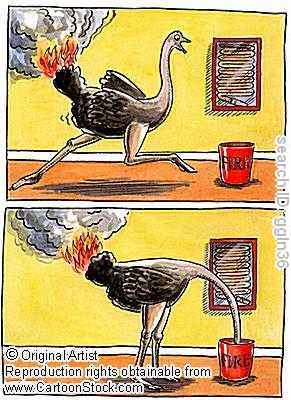 may by of any type: plastic, metal or even canvas, and of any size as long as they are “suitable for their intended service”, i.e. you should be able to carry water with them. Yes, we will have two buckets on board, which we will identify as our “fire buckets” as a mean of putting out a fire.
may by of any type: plastic, metal or even canvas, and of any size as long as they are “suitable for their intended service”, i.e. you should be able to carry water with them. Yes, we will have two buckets on board, which we will identify as our “fire buckets” as a mean of putting out a fire.
Please remember that water is used in order to cool down the fire, not to remove the oxygen or the combustible material, which would be the other two means of stopping a fire. In order to use water effectively to cool down a fire, the droplets should be as small as possible so energy created by the fire can be used up by evaporating the water. Small water droplets are created by splashing water out of the fire bucket. This is far more effective than emptying the entire water contents onto the fire in one “splash”. Use one hand to gently spray small amounts of water onto the fire.

